New York
state, United States
Introduction
New York, flag of

 constituent state of the United States of America (United States), one of the 13 original colonies and states. New York is bounded to the west and north by Lake Erie (Erie, Lake), the Canadian province of Ontario, Lake Ontario (Ontario, Lake), and the Canadian province of Quebec; to the east by the New England states of Vermont, Massachusetts, and Connecticut; to the southeast by the Atlantic Ocean and New Jersey; and to the south by Pennsylvania. The capital is Albany.
constituent state of the United States of America (United States), one of the 13 original colonies and states. New York is bounded to the west and north by Lake Erie (Erie, Lake), the Canadian province of Ontario, Lake Ontario (Ontario, Lake), and the Canadian province of Quebec; to the east by the New England states of Vermont, Massachusetts, and Connecticut; to the southeast by the Atlantic Ocean and New Jersey; and to the south by Pennsylvania. The capital is Albany.


 constituent state of the United States of America (United States), one of the 13 original colonies and states. New York is bounded to the west and north by Lake Erie (Erie, Lake), the Canadian province of Ontario, Lake Ontario (Ontario, Lake), and the Canadian province of Quebec; to the east by the New England states of Vermont, Massachusetts, and Connecticut; to the southeast by the Atlantic Ocean and New Jersey; and to the south by Pennsylvania. The capital is Albany.
constituent state of the United States of America (United States), one of the 13 original colonies and states. New York is bounded to the west and north by Lake Erie (Erie, Lake), the Canadian province of Ontario, Lake Ontario (Ontario, Lake), and the Canadian province of Quebec; to the east by the New England states of Vermont, Massachusetts, and Connecticut; to the southeast by the Atlantic Ocean and New Jersey; and to the south by Pennsylvania. The capital is Albany.Until the 1960s New York was the country's leading state in nearly all population, cultural, and economic indexes. Its displacement by California beginning in the middle of that decade was caused by the enormous growth rate that has persisted on the West Coast rather than by a large decline in New York itself. Texas overtook New York as the second most populous state in 2000. Still, New York remains one of the most populous states in the country, and its gross economic product exceeds those of all but a handful of countries throughout the world.
New York is situated across a region of contrast—from the Atlantic shores of Long Island and the skyscrapers of Manhattan through the rivers, mountains, and lakes of upstate New York to the plains of the Great Lakes region. With canals, railroads, and highways, New York is a principal gateway to the west from the Middle Atlantic and New England states and a hub for travel to and from much of the country. The cities of the state—from New York City through Albany, Utica, and Syracuse to Rochester and Buffalo on the Great Lakes—and their suburbs are home to more than four-fifths of all New Yorkers.
Both the New England and the Southern colonies had a great deal more to do with the movement toward revolution and with stabilizing the new country during its early decades than did New York, but, once the state's growth got under way, it attained a breakneck pace. The state—and New York City in particular—remains the centre of much of the country's economy and finance, as well as of many formative impulses in American art and culture, and the influence and image of both are major elements in national political life. However, the overwhelming presence of New York City has tended to divide the state socially and politically, causing long-standing problems for both the city and the state. Area 53,097 square miles (137,521 square km). Pop. (2000) 18,976,457; (2007 est.) 19,297,729.
Land (New York)
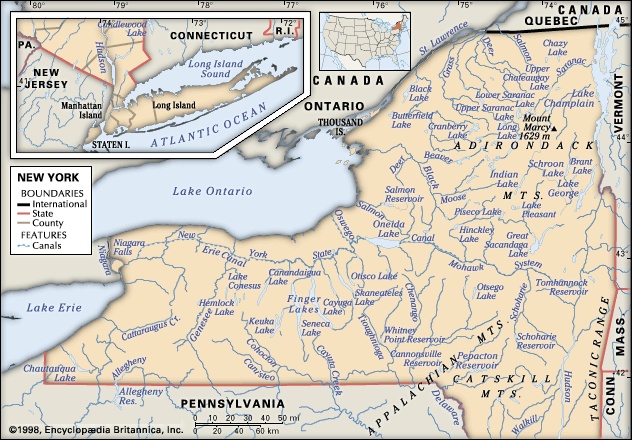
 Although New York state is inextricably linked with New York City in many people's minds, the state has a wide range of geographic and climatic conditions. During at least a part of the last Ice Age, most of New York was covered by glaciers; the only exceptions were southern Long Island, Staten Island, and the far southwestern corner of the state.
Although New York state is inextricably linked with New York City in many people's minds, the state has a wide range of geographic and climatic conditions. During at least a part of the last Ice Age, most of New York was covered by glaciers; the only exceptions were southern Long Island, Staten Island, and the far southwestern corner of the state.Relief
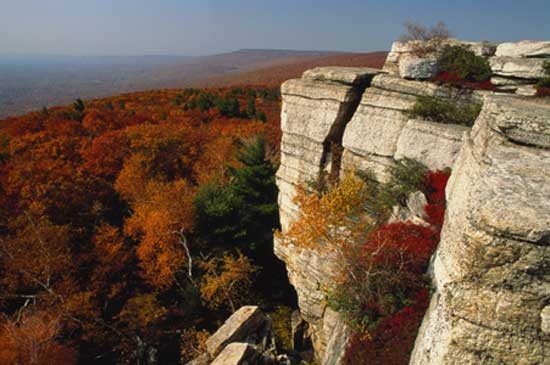 The movement of the glaciers left New York with nine distinct physiographic regions. Each has its own characteristic landforms, with distinctive geologic structures and patterns of erosion. In the northeast the Adirondack (Adirondack Mountains) upland is characterized by the highest and most rugged mountains in the state, reaching 5,344 feet (1,629 metres) at Mount Marcy (Marcy, Mount) and 5,114 feet (1,559 metres) at Algonquin Peak of Mount McIntyre. With the exception of some forestry activities, the region's main economic value is for recreation. A large part of it has been designated as a wilderness preserve by the state.
The movement of the glaciers left New York with nine distinct physiographic regions. Each has its own characteristic landforms, with distinctive geologic structures and patterns of erosion. In the northeast the Adirondack (Adirondack Mountains) upland is characterized by the highest and most rugged mountains in the state, reaching 5,344 feet (1,629 metres) at Mount Marcy (Marcy, Mount) and 5,114 feet (1,559 metres) at Algonquin Peak of Mount McIntyre. With the exception of some forestry activities, the region's main economic value is for recreation. A large part of it has been designated as a wilderness preserve by the state.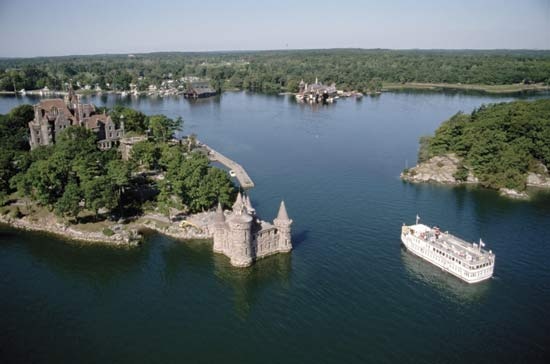 The St. Lawrence Lowlands extend northeastward from Lake Ontario to the ocean along the boundary with Canada. Within this area are three subdivisions: a flat to gently rolling strip of land along the St. Lawrence River (Saint Lawrence River and Seaway); a range of hills south and east of the plain; and, farther south and east, a long, narrow plain dotted with lakes.
The St. Lawrence Lowlands extend northeastward from Lake Ontario to the ocean along the boundary with Canada. Within this area are three subdivisions: a flat to gently rolling strip of land along the St. Lawrence River (Saint Lawrence River and Seaway); a range of hills south and east of the plain; and, farther south and east, a long, narrow plain dotted with lakes.The Hudson-Mohawk Lowland follows the Hudson River north from New York City to Albany and then turns west along the Mohawk River. The Hudson valley, between the Catskill Mountains on the west and the Taconic Range on the east, is from 10 to 20 miles (15 to 30 km) wide; the Mohawk valley reaches widths of 30 miles (50 km). Those routes provided access from New York City and New England into the hinterland of New York. Cutting pathways through the mountains of central and western New York, these rivers became the state's avenues of commerce, serving first as the basis of the Erie Canal and later as the route of the New York Central Railroad (New York Central Railroad Company) and of the Governor Thomas E. Dewey (New York State) Thruway.
To the east of the Hudson River lies the New England Upland, extending eastward into Massachusetts and Connecticut and southward across the lower Hudson valley into Pennsylvania.
Two small regions complete the geographic picture in southeastern New York. The Atlantic Coastal Plain, which extends from Massachusetts to Florida, takes in Long Island and Staten Island. A small finger of the eastern Piedmont region juts up from New Jersey for some distance along the west bank of the Hudson.
The Appalachian Highlands, the largest region in New York, comprises about one-half of the state, extending westward from the Hudson valley to the state's southern and western boundaries. The Catskill Mountains (the peaks of which reach some 2,000 to 4,000 feet 【600 to 1,200 metres】), the Finger Lakes Hills area, and the Delaware River basin are located in this region. The Catskills, with their mountains and lakes, are primarily a recreation area. The Finger Lakes region also provides many opportunities for summer and winter sports, and its valleys provide excellent grasslands for dairying. The Delaware basin is a mixed-farming area.
A plateaulike region known as the Erie-Ontario Lowlands lies to the north of the Appalachian Highlands and west of the Mohawk valley and extends along the southern shores of the Great Lakes. It is composed of lake plains bordering the Great Lakes that extend up to 30 miles (50 km) inland from the lakes. Because of the moderating influence of the lakes on the weather, the region has become an important fruit-growing area. Between the lake lowlands and the western reaches of the Adirondacks and north of Oneida Lake lies the Tug Hill Upland, which is one of the least-settled parts of the state because of its poor soil and drainage and its excessive winter snow conditions.
Drainage
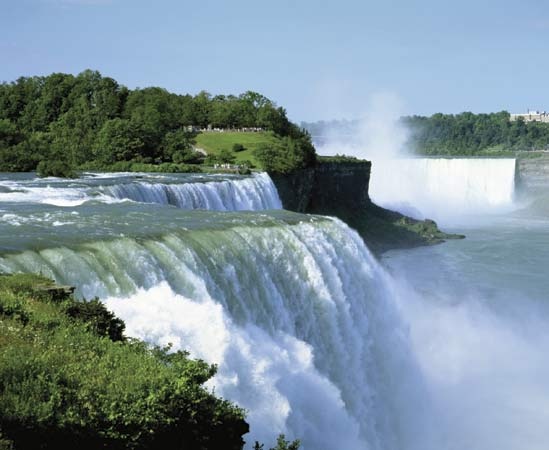 Among New York's special geographic features are its two major shorelines: some 130 miles (210 km) bordering the Atlantic and 370 miles (600 km) on Lakes Erie and Ontario; in addition, the western shore of Lake Champlain (Champlain, Lake) stretches along the northeast corner of the state. The state also has some 8,000 lakes and 9 major rivers. The Hudson and Mohawk rivers have played the most important roles in the state's history, but the Genesee (Genesee River) and Oswego, flowing northward into Lake Ontario, also have been important. The Delaware (Delaware River), Susquehanna (Susquehanna River), and Allegheny (Allegheny River) drain the southern and western portions of the state and provide a large part of New York City's water supply. The East River connects Long Island Sound with New York Bay and separates Long Island and Manhattan. The most dramatic of the waterfalls that dot the state is Niagara Falls, a source of much hydroelectric power as well as one of the major scenic attractions of the Northeast.
Among New York's special geographic features are its two major shorelines: some 130 miles (210 km) bordering the Atlantic and 370 miles (600 km) on Lakes Erie and Ontario; in addition, the western shore of Lake Champlain (Champlain, Lake) stretches along the northeast corner of the state. The state also has some 8,000 lakes and 9 major rivers. The Hudson and Mohawk rivers have played the most important roles in the state's history, but the Genesee (Genesee River) and Oswego, flowing northward into Lake Ontario, also have been important. The Delaware (Delaware River), Susquehanna (Susquehanna River), and Allegheny (Allegheny River) drain the southern and western portions of the state and provide a large part of New York City's water supply. The East River connects Long Island Sound with New York Bay and separates Long Island and Manhattan. The most dramatic of the waterfalls that dot the state is Niagara Falls, a source of much hydroelectric power as well as one of the major scenic attractions of the Northeast.Soils
New York soils can be grouped into categories based on their parent material. One of the most productive groups is found in regions of lime-rich glacial till. Where drainage is good and the terrain not too steep, these soils are excellent for agriculture. They occur in a broad belt across the state and into the Hudson valley. Another lime-rich soil group is found in areas that were formerly glacial lake beds, such as the Erie-Ontario Lowlands and large parts of the Hudson and St. Lawrence valleys. Soils of this group are fine-textured and are characterized by level topography. Where drainage is not a problem, these soils are quite suitable for agriculture. Alluvial soils, formed from the sediments of glacial meltwater and the floodwaters of present-day streams, are found in many valley bottoms, especially in the Appalachian Highlands and along the Mohawk and Hudson rivers. Most of Long Island is also covered by alluvial soils, which often have excellent productive potential. Other soils less suitable for agriculture are derived from lime-poor glacial till, such as those north of the major limestone outcroppings near Lake Ontario, or from material that is too shallow or coarse, such as those in the rugged mountainous areas of the state or in the sandy region west and north of Albany.
Climate
The early Dutch settlers found that New York's climate fell far short of their expectations. Since Manhattan is actually Mediterranean in latitude, these early settlers were rather bewildered to encounter its snowy, freezing winter weather. If Manhattan was uncomfortably cold and wet in the winter months, the rest of the state must have been an even greater disappointment.
Average July temperatures range from 77 °F (25 °C) in New York City to 64 °F (18 °C) at Indian Lake in the Adirondacks; averages in January range from 33 °F (0.5 °C) on Long Island to 14 °F (−10 °C) at Stillwater Reservoir in the Adirondacks. These figures represent the extremes, but there are substantial differences in climate between New York City and upstate Albany, Buffalo, Rochester, and Syracuse. A tendency to cloudiness across the state results in few completely clear days.
Precipitation ranges from 32 to 45 inches (810 to 1,140 mm) a year, with the Catskills receiving the greatest amount, while the Erie-Ontario Lowlands receive the least. The region around Syracuse receives an unusual amount of lake-effect snow (an annual average of about 115 inches 【2,900 mm】) because of its location near Lake Ontario; the Buffalo area, on Lake Erie, is also renowned for its annual heavy snowfalls (averaging some 95 inches 【2,400 mm】).
Plant and animal life
More than three-fifths of New York state is forested woodland. Some 150 kinds of trees, including such southern species as the tulip tree (yellow poplar) and sweet gum, are found in the state. Most woodland, however, is dominated by a small number of northern hardwoods, chiefly beeches and sugar maples in association with species of ash, basswood, cherry, birch, red maple, oak, and, occasionally, conifers such as white pine and hemlock. The spruce-fir association found in extensive parts of the Adirondacks and the largely oak-dominated forests in southeastern New York are the major exceptions to the northern hardwood forests.
Small mammals such as deer mice, eastern cottontails, snowshoe hares, woodchucks, gray squirrels, muskrats, and raccoons are common. Larger mammals include white-tailed deer, beavers, and black bears. New York is host to numerous migratory birds. Year-round residents include eastern meadowlarks, American goldfinches, cardinals, eastern bluebirds, cedar waxwings, bluejays, several kinds of woodpeckers and owls, red-tailed hawks, ruffed grouses, mallards, and common house sparrows, introduced to North America from Europe in the early 1850s.
People
Population composition
Since the colonial period much of New York's growth has resulted from immigration, both from other states and from abroad. Before the American Revolution the Dutch, English, Scots, and Germans were the primary settlers; they were followed in the first half of the 19th century by New Englanders spreading across developing parts of upstate New York and into Westchester county and northern Long Island. The influx of European immigrants came first from the northern and central parts of the Continent and later from southern countries.
The primary countries of origin are Italy, parts of the former Soviet Union (notably, Russia and Ukraine), Poland, Germany, Ireland, the United Kingdom, and Canada. Many of today's New Yorkers either are foreign-born or have parents who were born abroad, and a significant percentage of people are from a great number of other parts of the world besides Europe and Canada. Nearly half of the population is Roman Catholic, and about one-tenth is Jewish.
The nonwhite portion of the population grew significantly during the 20th century. The first large-scale influx of African Americans from the Southern states occurred during World War I, but it was small compared with the migration that occurred during and after World War II. In 1940 only 4.4 percent of the population was nonwhite, but by the beginning of the 21st century the proportion had increased to about one-sixth, concentrated in the state's metropolitan areas and, within those areas, in the central cities. In the late 20th and early 21st centuries, many immigrants of African descent came from diverse areas in the Caribbean and Africa, and they represent different religions, linguistic groups, and social backgrounds.
Puerto Ricans are another group that has had a significant impact on the economy and culture of New York since World War II. Economic depression in Puerto Rico led to heavy migration to the continental United States, chiefly to New York, during the 1950s and early '60s. Later economic recovery resulted in a considerable reduction in migration, the number of entrants being largely offset by the number of returnees to Puerto Rico. Several hundred thousand people of Puerto Rican origin now reside in the state, mostly in New York City. Dominicans and other Latinos have added to the number of Spanish-speaking immigrants.
Settlement patterns
 The cultural and social distinctions between various parts of New York state have diminished. Upstate cities, for example, are nearly as varied ethnically as New York City. Certain cultural and social characteristics introduced by early settlers remain visible and, to some degree, still influence lifestyles. During the colonial period and for a number of years after the American Revolution, New England was a major source of migrants to New York, and there are traces of the New England influence, particularly in the architecture and small-town planning of the northern shore of Long Island and in northern Westchester county. The Dutch influence around Albany remains in little more than place-names and street names, plus some preserved or rehabilitated Dutch architecture. German and Scottish settlers have left their mark in the Schoharie valley and parts of the Hudson and Mohawk valleys (German), in Orange and Ulster counties, and in the Cherry Valley area (Scottish).
The cultural and social distinctions between various parts of New York state have diminished. Upstate cities, for example, are nearly as varied ethnically as New York City. Certain cultural and social characteristics introduced by early settlers remain visible and, to some degree, still influence lifestyles. During the colonial period and for a number of years after the American Revolution, New England was a major source of migrants to New York, and there are traces of the New England influence, particularly in the architecture and small-town planning of the northern shore of Long Island and in northern Westchester county. The Dutch influence around Albany remains in little more than place-names and street names, plus some preserved or rehabilitated Dutch architecture. German and Scottish settlers have left their mark in the Schoharie valley and parts of the Hudson and Mohawk valleys (German), in Orange and Ulster counties, and in the Cherry Valley area (Scottish).The distinction between upstate and downstate is normally along political lines—upstate, conservative; downstate, liberal. Political differences are matched by social differences. Downstate is divided between New York City and the suburbs, and within the city differences between the boroughs are important. Although Manhattan has many low-income residents, it is more characterized as a centre for sophisticated lifestyles and liberal politics. In the outer boroughs are relatively stable ethnic neighbourhoods and communities in the process of changing their ethnic or racial makeup; they tend to be more conservative than those in Manhattan but generally are oriented toward the Democratic Party. The suburbs are dominated by white middle- and high-income families living in detached houses, though the income spread in the suburbs has increased, and the inner suburbs are beginning to resemble the city's outer boroughs.
The rural upstate areas must be distinguished from the upstate cities and their suburbs. Rural New York remains conservative both politically and socially. The city regions vary from relatively sophisticated Rochester, with its heavy concentration of white-collar technical and managerial employees, to the more conservative Syracuse–central New York area. Buffalo, with its emphasis on heavy industry, has a large blue-collar population.
Demographic trends
Beginning in the 20th century, much internal migration took place within the state. Higher- and middle-income whites moved to the suburbs, leaving low-income whites and African Americans within the central cities. Likewise, much economic activity, notably manufacturing and the headquarters of corporations, also moved to the suburbs. This movement of people and economic activity resulted in an urban crisis familiar across the United States: an increasing need for the cities to combat crime and other symptoms of poverty, coupled with the removal of the social and economic resources to do so. Although New York City's population began rebounding in the late 20th century and the economic strength of the state's large metropolitan areas generally has been growing, the cities' poor increasingly have been unable to participate in the prosperity and seem likely to slip still farther behind.
Economy
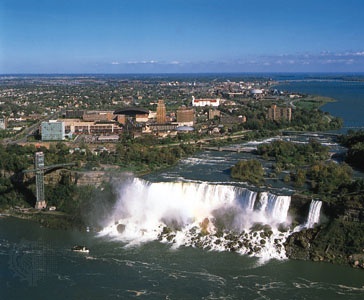 New York state's economy ranks among the largest in the world and accounts for a significant portion of the gross domestic product of the United States. In addition, since the early 21st century, New York's economic policy has improved its business climate by encouraging the building of new and expanded corporate facilities and increasing the number of new jobs. However, in many ways New York's economy is similar to those of the other Northeastern states. The service sector predominates, though manufacturing is also important. Although the economies of other states are growing more rapidly, New York still has great economic strength. The state has, for example, a complex network of nearly every form of transportation. Its resources of electrical power for domestic and commercial use are enormous, including conventional coal- and oil-burning thermal plants, hydroelectricity from the Niagara region, and a large nuclear capability.
New York state's economy ranks among the largest in the world and accounts for a significant portion of the gross domestic product of the United States. In addition, since the early 21st century, New York's economic policy has improved its business climate by encouraging the building of new and expanded corporate facilities and increasing the number of new jobs. However, in many ways New York's economy is similar to those of the other Northeastern states. The service sector predominates, though manufacturing is also important. Although the economies of other states are growing more rapidly, New York still has great economic strength. The state has, for example, a complex network of nearly every form of transportation. Its resources of electrical power for domestic and commercial use are enormous, including conventional coal- and oil-burning thermal plants, hydroelectricity from the Niagara region, and a large nuclear capability.State government plays both regulatory and promotional roles in the economy. The Public Service Commission controls the rates charged by public utilities, and the Division of Housing and Community Renewal encourages the development of affordable housing and community preservation programs. The Department of Commerce aids in attracting new economic activity to the state, providing information and assistance to industries seeking to locate there, giving financial support to local communities interested in developing industrial parks, and offering other incentives to encourage the location of more industries within such areas.
New York tends to have somewhat lower unemployment rates during downturns in the national economy than does the rest of the country, but it also recovers less rapidly. This is largely a result of the state's economic mix and its heavy dependence on nonmanufacturing activities.
Almost one-fourth of New York's workforce is unionized, about double the national average. Unionization has grown rapidly in the service sector among such government employees as teachers, sanitation workers, police, and firefighters. The nature of labour-management relations varies considerably from industry to industry, with workers in construction and the garment and apparel industries wielding great power. The state legislature frequently devotes attention to the field of labour relations, particularly public-sector employee relations.
Agriculture
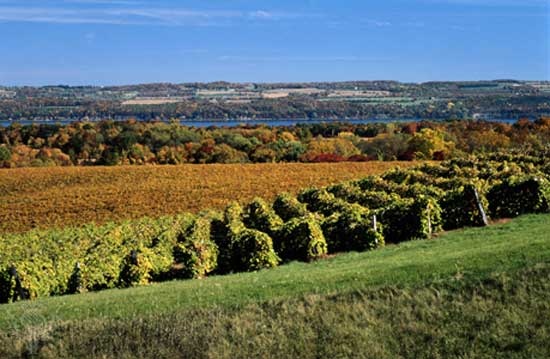 Farmland covers nearly one-third of the state's land area; about three-fifths of New York's farmland is cropland. Dairying is the most important source of farm income, providing more than one-half of the total. Other important sources of farm income are poultry and eggs, livestock products, fruits, vegetables, and field crops. The state raises a variety of horticultural specialties, including nursery products, crops grown in greenhouses, flower bulbs, and seeds, and it competes with Vermont in the production of maple sugar. The fruit and vegetable farms supply the food-processing industry with such products as apples, cherries, peaches, currants, strawberries, tomatoes, peas, beans, sweet corn, and cabbage. There is also a long-standing winemaking tradition that began commercially in the state in the early 1800s. New York is one of the country's largest wine producers; particularly well known for their wines are the Hudson valley and Finger Lakes regions.
Farmland covers nearly one-third of the state's land area; about three-fifths of New York's farmland is cropland. Dairying is the most important source of farm income, providing more than one-half of the total. Other important sources of farm income are poultry and eggs, livestock products, fruits, vegetables, and field crops. The state raises a variety of horticultural specialties, including nursery products, crops grown in greenhouses, flower bulbs, and seeds, and it competes with Vermont in the production of maple sugar. The fruit and vegetable farms supply the food-processing industry with such products as apples, cherries, peaches, currants, strawberries, tomatoes, peas, beans, sweet corn, and cabbage. There is also a long-standing winemaking tradition that began commercially in the state in the early 1800s. New York is one of the country's largest wine producers; particularly well known for their wines are the Hudson valley and Finger Lakes regions.Manufacturing, services, and taxation
A declining proportion of New York's workforce is engaged in manufacturing activities. In 1947 more than one-third of the state's employed population was in manufacturing, but by the early 21st century that proportion had dropped to only about one-tenth of the total. New York's service and manufacturing economy remains diverse. It includes financial services; printing and publishing; fashion, apparel, and textiles; food processing; optics and imaging instruments; computer hardware and software; biomedical and chemical products; industrial, electric, and electronic machinery and systems; and transportation equipment and distribution services.
There is some economic specialization within different parts of the state. Services and activities related to finance, insurance, and real estate are more concentrated in the New York City metropolitan area than in upstate New York. Buffalo is strong in heavy industry, while Rochester dominates the manufacture of photographic and optical equipment and is primarily responsible for the state's strong position in instrument production.
Syracuse ranks high in the state in the production of primary metals, machinery, and paper and allied products, as well as in educational employment. The Utica- Rome area specializes in machinery and primary metals, while the Albany- Troy-Schenectady area is strong in the production of paper and allied products. Albany, as the state capital, leads in government employment. Binghamton, the site of a forerunner of the International Business Machines Corporation (IBM), has a concentration of employment in the computer and business-machine field.
New York state residents pay one of the highest per capita tax rates in the United States, a system made possible by the state's relatively healthy economic base. The state imposes income, sales, business, and excise taxes. Local revenues are derived mainly from property and sales taxes. The broad state base plus the widespread use of local sales taxes allows New York to rely less on local property taxes than do other large or heavily populated states. Since the late 20th century, the size of New York's government has been reduced through consolidation and privatization, prompting a series of tax cuts designed to make the state more competitive economically.
Transportation
A great part of New York's economic advantage is its location on important natural transportation routes and facilities that connect urban centres within and without the state.
The Erie Canal, opened in 1825, tied New York City and its port to Buffalo and the westward-expanding country. The main railroad system followed the route of the canal, with feeder lines that jutted north and south into the remainder of the state. After World War II the limited-access Thruway stretched from New York to the Pennsylvania state line, passing through Albany, Utica, Syracuse, Rochester, and Buffalo. The basic paths of these main transportation routes are not substantially different from those that were used by the state's original settlers.
With the completion in 1918 of the New York State Barge Canal System (now called the New York State Canal System), which incorporated the old Erie Canal, New York had the country's most extensive inland waterway system. The canal system stretches some 520 miles (840 km) and has more than 50 locks. Although it is an important means for moving bulk goods—particularly petroleum products, a major share of the freight hauled—the tonnage it carries annually has dropped considerably.
The railways (railroad) first challenged the supremacy of the canal as a carrier of goods. Beginning in the mid-19th century with the establishment of the New York Central Railroad, a system was built that tied New York's major cities to Chicago, Boston, Montreal, and other urban centres. Although the number of passengers carried has declined, the railroads remain important handlers of freight. Much of this freight originates via the facilities of the Port Authority of New York and New Jersey, still one of the largest and busiest port complexes in the United States, handling about one-tenth of all the country's imports and a large proportion of all immigrants to the United States.
Central to the highway system are the limited-access highways. The Thruway connects at Albany to the Adirondack Northway, which extends northward to Canada. In central New York a major highway runs from the Pennsylvania state line to Canada, passing through Binghamton, Syracuse, and Watertown. At Syracuse this route intersects with the Thruway, maintaining the city as a transportation hub and accounting in large part for its economic viability. Another limited-access expressway extends across the southern tier of the state. On Long Island a set of east-west highways ties the island to New York City, New England, and upstate New York.
The New York City metropolitan area, with its combination of subways, buses, and railroads, has the most complex commuter system in the country. The vast New York transit system provides intracity passenger transport. Commuter railroads serve suburban Long Island, Westchester county, New Jersey, and Connecticut. Many of these transportation networks were brought under the control of a single agency, the Metropolitan Transportation Authority, in 1968.
The three largest airports in the New York City metropolitan area are John F. Kennedy International, La Guardia, and Newark Liberty International, in New Jersey. Other airports providing national and international service are located in Albany, Buffalo, Islip, Rochester, and Syracuse, among others, and the state has a number of regional and county airports.
Government and society
Constitutional framework
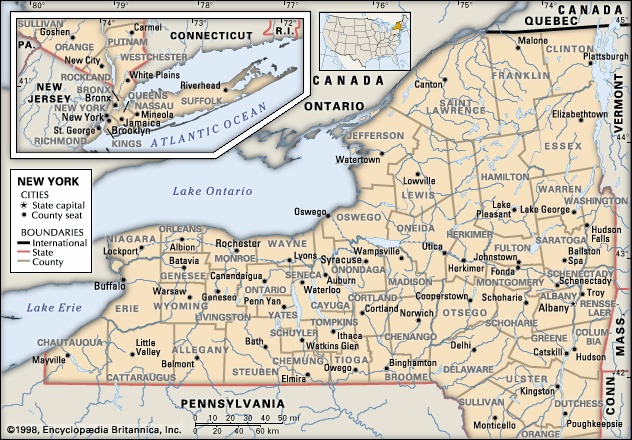
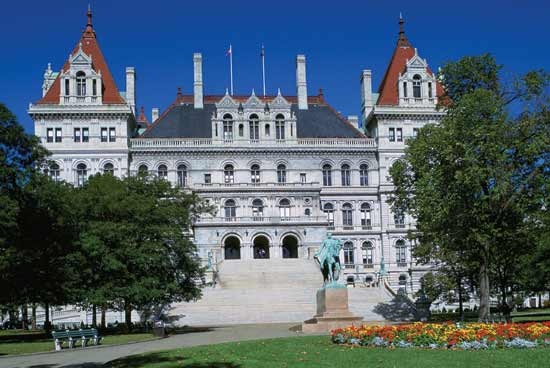 New York's constitution prescribes the distribution of powers among the branches of state government as well as the system of local government throughout the state. However, the document is extremely detailed and includes provisions that most constitutional scholars consider more appropriately treated in legislative statutes than in a constitution. Because of the detail, articles tend to become quickly outdated, necessitating frequent conventions for revision. Since the first convention in 1777, others have been held at roughly 20- to 25-year intervals. The constitution requires that the question of holding a convention be placed before the voters of the state every 20 years.
New York's constitution prescribes the distribution of powers among the branches of state government as well as the system of local government throughout the state. However, the document is extremely detailed and includes provisions that most constitutional scholars consider more appropriately treated in legislative statutes than in a constitution. Because of the detail, articles tend to become quickly outdated, necessitating frequent conventions for revision. Since the first convention in 1777, others have been held at roughly 20- to 25-year intervals. The constitution requires that the question of holding a convention be placed before the voters of the state every 20 years.The first constitution established a bicameral legislature and provided for the first popularly elected governor in the United States. The current constitution (1894) has been amended more than 200 times. Its provisions include a merit civil-service system, limitations on disposal of the state's forest preserve, a commitment to public education, and the first constitutional definition of state-local relations.
The state government is led by a strong governor who has power over appointments and budget. The governor is restricted, however, by a number of independently appointed or elected officials. The Board of Regents, for example, which presides over education, is appointed by the legislature. An independently elected comptroller acts as auditor for both state and local governments.
The bicameral legislature comprises a Senate of 61 members and an Assembly of 150. Members of both houses are elected for two-year terms. Each house has standing committees concerned with issues of public policy. The state also has numerous nonlegislative commissions—appointed by the governor, by the legislature, or by both—on various governmental and public-policy problems.
New York is divided into 12 judicial districts. Each district has several elected judges, and together they form the Supreme Court. Four judicial departments act as appeal divisions from the supreme and inferior courts. The highest court is the Court of Appeals. The governor appoints the judges to the appellate departments from those elected to the Supreme Court, and the seven justices serving on the Court of Appeals are appointed by the governor with the approval of the Senate for 14-year terms. The Court of Claims hears cases against the state. Local courts include county courts, family and surrogate courts, and the court system of New York City.
Much legislative debate revolves around the allocation of state aid to local jurisdictions. The constitution has contained a provision for home rule by local governments since 1896, but court interpretations of the provision, which gives the state the power to act in any matter in which there is a state concern, have tended to weaken the home-rule concept. Moreover, the increasing interdependence of the state and its parts caused by urbanization and industrialization inevitably has reduced the autonomy of local jurisdictions.
The state has 62 counties, which are divided into about 1,500 towns and villages. Urban areas may be incorporated as either cities or villages. Villages remain a part of the town in which they are located, and their residents pay town as well as village taxes.
Unlike those states in which either town or county government is weak, New York has strong local governments of both types. This situation often leads to overlap in providing governmental services outside the cities. Special districts include port and bridge, health, and fire districts, as well as regional market authorities. The Port Authority (Port Authority of New York and New Jersey) is one of the largest special districts, operating bridges, harbours, and related facilities throughout the New York City metropolitan area, including those in northern New Jersey.
Cities and villages generally are governed by a mayor and a council; only a few cities use the city manager plan. Some of the larger cities have a second legislative body, often called the Board of Estimate. In New York City the mayor, the president of the city council, the comptroller, and the five borough presidents serve on this body. In other cities membership usually includes the mayor, the president of the city council, and one or more high-ranking fiscal officers.
The state-local governing system of New York places heavy responsibilities on local governments, and more than half of the state budget consists of aid to local government. Most of the aid is for public schools; other allocations go to welfare, health, highways, and housing and urban renewal, among other projects.
Political process
New York state politics has generally been defined by strong Democratic Party control in New York City and dominance by the Republican Party upstate and on Long Island. Since 1920 both Democratic and Republican governors have held power and the legislature has tended to be Republican-dominated, although since the mid-1970s the Assembly has tended to be controlled by the Democrats. Both the Democrats and the Republicans have strong statewide party organizations, but New York is one of the few states in which third and fourth parties have thrived and often played important roles in elections.
Health and welfare
New York state has some of the finest hospital and medical education facilities in the United States. Major medical centres in the New York City metropolitan area include Beth Israel and Mount Sinai hospitals, the hospitals and medical schools of Columbia University and New York University, and Memorial Sloan-Kettering Cancer Center. Among the notable facilities upstate are those associated with the State University of New York (New York, State University of (SUNY)) (SUNY) Upstate Medical University in Syracuse and Cornell University in Ithaca. The great majority of New Yorkers are covered by hospital and surgical insurance. Medicaid and its associated programs provide health care for an estimated one in five New Yorkers. Social welfare is a major enterprise in New York state. State benefits range from aid to families with dependent children to the support of nursing homes. Many state residents also participate in the federal food stamp program.
Education
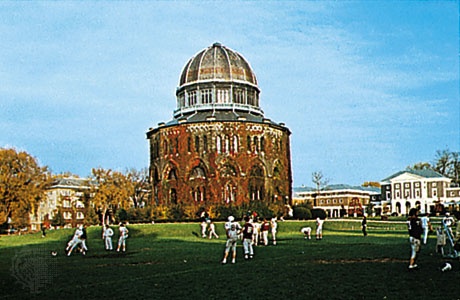 New York has one of the highest rates of per-pupil expenditures for public education among the states. The public school system, with compulsory schooling between the ages of 6 and 16 or 17, had its beginnings in the colonial period. Schools were established by churches with government support as early as 1638 in New Amsterdam. It was not until 1791, however, that the state's first public school was established. Some state support was granted in 1795 to elementary schools, and in 1812 a permanent system of public schools was established. Parent-paid fees provided part of the support until all elementary schools became free in 1867. During the 1850s a few cities established public secondary schools, which subsequently spread across the state during the second half of the century.
New York has one of the highest rates of per-pupil expenditures for public education among the states. The public school system, with compulsory schooling between the ages of 6 and 16 or 17, had its beginnings in the colonial period. Schools were established by churches with government support as early as 1638 in New Amsterdam. It was not until 1791, however, that the state's first public school was established. Some state support was granted in 1795 to elementary schools, and in 1812 a permanent system of public schools was established. Parent-paid fees provided part of the support until all elementary schools became free in 1867. During the 1850s a few cities established public secondary schools, which subsequently spread across the state during the second half of the century.A system called the University of the State of New York—one of the most comprehensive educational organizations in the world—governs all educational activities in the state. It was established in 1784 and its governance placed under a Board of Regents. In 1904 the state legislature made the Board of Regents responsible for all educational activities in the state. The board selects the state commissioner of education, approves the establishment of new colleges, licenses entry into professions, approves new degree programs, and advises the legislature on all educational issues.
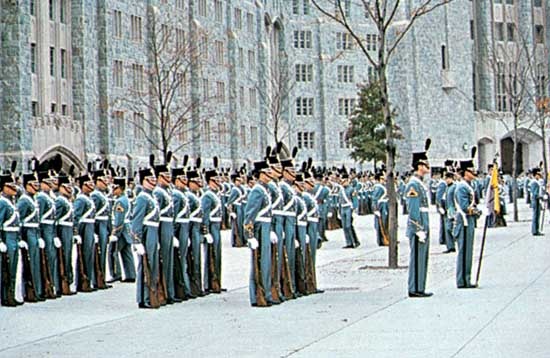 In 1948, public institutions of higher education, primarily teachers colleges and two-year agricultural and technical institutions, plus newly established institutions, were incorporated into SUNY (New York, State University of (SUNY)), an institution distinct from the University of the State of New York but a part of that larger entity. Before then, private institutions had dominated higher education. In addition to the medical school at Syracuse, major SUNY centres are located at Stony Brook, Albany, Binghamton, and Buffalo. A variety of other state institutions and community colleges are supported in about equal parts by the state, the local community, and student fees. The City University of New York (City University of New York, The (CUNY)), supported by the state and by New York City, provides a great variety of programs ranging from those offered by two-year community colleges to graduate education. One of the oldest service academies in the world, the United States Military Academy, was founded at West Point in 1802.
In 1948, public institutions of higher education, primarily teachers colleges and two-year agricultural and technical institutions, plus newly established institutions, were incorporated into SUNY (New York, State University of (SUNY)), an institution distinct from the University of the State of New York but a part of that larger entity. Before then, private institutions had dominated higher education. In addition to the medical school at Syracuse, major SUNY centres are located at Stony Brook, Albany, Binghamton, and Buffalo. A variety of other state institutions and community colleges are supported in about equal parts by the state, the local community, and student fees. The City University of New York (City University of New York, The (CUNY)), supported by the state and by New York City, provides a great variety of programs ranging from those offered by two-year community colleges to graduate education. One of the oldest service academies in the world, the United States Military Academy, was founded at West Point in 1802.There are more than 230 private institutions of higher education, including some of the best-known universities in the country. Columbia University, founded in 1754 as King's College, is known for the high quality of its graduate instruction and for the national influence of its teachers college. Cornell University (1865), the base for the agriculture, human ecology, veterinary medicine, and industrial- and labour-relations units of the State University, is a member of the Ivy League, as is Columbia. Fordham University (1841) and St. John's University (Saint John's University) (1870) are perhaps the best-known of the state's many Roman Catholic colleges and universities. The University of Rochester (Rochester, University of) (1850), known for its programs in music and the natural sciences, and Syracuse University (1870), home of the Maxwell School of Citizenship and Public Affairs, the first university unit established for training students for public service, are also well-known private institutions. Other well-regarded institutions include Colgate University (1819), Hamilton College (1812), Union College (1795), St. Lawrence University (1856), Bard College (1860), Skidmore College (1903), Barnard College (1889; affiliated with Columbia), and Vassar College (1861); the latter two institutions are among the Seven Sisters schools.
Cultural life
Cultural institutions
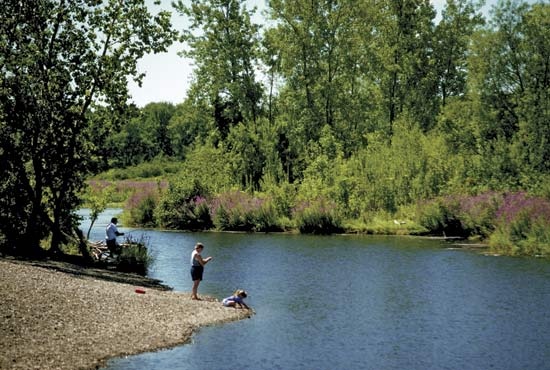 The state is home to some 1,300 museums and art galleries, more than 200 theatres, and dozens of performing arts centres. Much of the style and tone of life in the United States is set in New York City, which remains the artistic and cultural capital of the country. The fashion industry is headquartered in its garment district. The heart of the country's live theatre is found on and off Broadway; many television programs originate in New York City, where several broadcast and cable networks have their home offices, and many motion pictures are filmed on its streets. The city's museums, theatres, orchestras, dance companies, and other institutions set standards across the country. This cultural preeminence was celebrated by E.B. White (White, E.B.) when he wrote:The city is like poetry. It compresses all life, all races and breeds, into a small island and adds music and the accompaniment of internal engines. The island of Manhattan is without any doubt the greatest human concentrate on earth, the poem whose magic is comprehensible to millions of permanent residents—but whose full meaning will always remain elusive.
The state is home to some 1,300 museums and art galleries, more than 200 theatres, and dozens of performing arts centres. Much of the style and tone of life in the United States is set in New York City, which remains the artistic and cultural capital of the country. The fashion industry is headquartered in its garment district. The heart of the country's live theatre is found on and off Broadway; many television programs originate in New York City, where several broadcast and cable networks have their home offices, and many motion pictures are filmed on its streets. The city's museums, theatres, orchestras, dance companies, and other institutions set standards across the country. This cultural preeminence was celebrated by E.B. White (White, E.B.) when he wrote:The city is like poetry. It compresses all life, all races and breeds, into a small island and adds music and the accompaniment of internal engines. The island of Manhattan is without any doubt the greatest human concentrate on earth, the poem whose magic is comprehensible to millions of permanent residents—but whose full meaning will always remain elusive.Cultural activities are not confined to New York City, however. Many art museums are located in the state's large and small cities. The Albright-Knox Art Gallery, in Buffalo, has collections of contemporary American and European paintings and sculptures. In Rochester are the Memorial Art Gallery of the University of Rochester, the Rochester Museum and Science Center, the Strong National Museum of Play, and the International Museum of Photography and Film at the George Eastman House. Syracuse's Everson Museum of Art houses collections of American and international art in a building designed by I.M. Pei (Pei, I.M.), and the city's Erie Canal Museum is devoted to the history of the canal. The New York State Museum in Albany is the oldest (founded 1836) state museum in the United States. Symphony orchestras outside New York City include those of Buffalo and Rochester, while the Eastman School of Music in Rochester is internationally known. Fine architecture is found across the state, and the performing arts are pursued by professional and amateur groups. The cultural life of the state's many college and university towns often is centred on these institutions.
The Saratoga Performing Arts Center in Saratoga Springs is the summer home of the Philadelphia Orchestra and the New York City Ballet. Theatrical performances also are held at this modern cultural centre. The Chautauqua Institution, founded in 1874 on Chautauqua Lake in southwestern New York, inspired the national chautauqua movement of public lectures and adult education during the late 19th and early 20th centuries; the institution now offers a wide range of cultural and educational activities, including concerts, opera, drama, and lectures.
Cooperstown, founded by the father of the novelist James Fenimore Cooper (Cooper, James Fenimore), is known as the village of museums, the best known of which is the National Baseball Hall of Fame and Museum (Baseball Hall of Fame). At the Angel Moroni Monument on Hill Cumorah, near Palmyra, an annual pageant depicts the founding of the Mormon Church. South of Palmyra are the Greyton H. Taylor Wine Museum, in Hammondsport, and the Corning Museum of Glass, in Corning. Historic homes, forts, and battlefields are found throughout the state; more than one-third of all the battles of the American Revolution, including the Battles of Saratoga (Saratoga, Battles of), were fought in New York.
New York was the first state in the Union to establish a program for continuing financial support of the arts. The New York State Council on the Arts, which administers the program, funds organizations in the fields of the performing arts, visual arts, film and media, and special programs.
Sports and recreation
New York is the home of a number of important sports events, notably the annual U.S. Open (United States Open Tennis Championships) tennis tournament, held at Flushing Meadows. The Belmont Stakes, part of American horse racing's Triple Crown, takes place at Belmont Park, near New York City, each June. The Olympic Winter Games (Olympic Games) have been held twice at Lake Placid (1932 and 1980). The state also has many professional sports teams, including, in gridiron football, the Buffalo Bills and the New York Giants and Jets, which, like the New York Red Bulls (major league football 【soccer】), play in northern New Jersey. In men's basketball, the Knicks frequently have been one of the standout teams, and baseball's Mets and Yankees (both in New York City) have had storied histories. The New York Liberty was one of the charter teams of women's professional basketball. Professional ice hockey teams are the New York Islanders (Long Island) and Rangers and the Buffalo Sabres.
The variety of New York's geography provides not only great beauty but also opportunities for recreation, relaxation, and a study of the past. In 1885 New York established the country's first state park (Niagara Falls State Park), and it has developed an extensive system of state parks and recreation areas. With the cool summers of the Adirondacks, the snowy slopes of the Catskills, the ocean beaches and lakes, and a variety of aquatic sports, New York state has a broad recreational base.
Press and broadcasting
Several major publishing houses have their headquarters in New York City, as do a large number of national magazines. The central offices of many of the country's largest corporations are located there, supporting a great many banks, public-relations firms, advertising agencies, management consultants, and law firms. Because of this concentration of business and culture, New York City maintains a leading national position in American life.
Newspaper publishing in New York dates to colonial times, and by the early 19th century more than 100 papers were being published in the state. Two of New York City's major papers, The New York Times and The Wall Street Journal, are now also published in national editions. In addition, dozens of cities upstate support daily and weekly newspapers; some also have local business journals. Book publishers of all descriptions, including university presses and other scholarly and trade publishers, are scattered throughout the state.
History
First peoples
Two major groups of Native American (American Indian) peoples were living in the New York region when Europeans first arrived: the Algonquian (Algonquian languages)-speaking Mohican (Mahican) and Munsee tribes near the Atlantic coast and, farther inland, the five tribes of the Iroquois— Mohawk, Oneida, Onondaga, Cayuga, and Seneca—that formed the Iroquois Confederacy between 1570 and 1600. (The Tuscarora joined the confederacy in 1722.) This association of Native American tribes, with its advanced social and governmental institutions, reached the height of its power about 1700. The alignment of these tribes with the British against the French, with whom the confederacy's traditional enemies were allied, probably enabled the British to emerge as victors in the nearly 150 years of struggle between the two European powers in northern North America.
Colonial period
New York was originally settled as a colony of the Netherlands (Netherlands, The) following Henry Hudson (Hudson, Henry)'s exploration in 1609 of the river later named for him. In 1624 at what is today Albany, the Dutch established Fort Orange as the first permanent European settlement in New York. One year later New Amsterdam was established at the southern end of Manhattan Island. To legalize that settlement, Peter Minuit (Minuit, Peter), the Dutch governor, paid the Indians merchandise worth about 60 Dutch guilders at the time—converted to the legendary $24. Although the Dutch established several settlements along the Hudson, their interest was more in trade than in permanent agricultural development. Thus, while its trading posts prospered and aided the general expansion of its empire, the Netherlands planted no deep roots of permanent colonization in New York. The most likely explanation for this lies in the economic prosperity and social stability of the homeland. The Dutch citizens had no strong economic motivations to move overseas, nor were there sufficient religious or political quarrels to promote any such movement. An English (British Empire) fleet sailed into New York harbour in 1664; Gov. Peter Stuyvesant (Stuyvesant, Peter) was obliged to surrender, the citizens and the Dutch government having no will to fight. Although controversy ensued for several years, the colony was firmly in English hands by 1669. Under the English it was renamed New York, for James, duke of York (later James II).
Despite this change in ownership and sovereignty, however, the colony developed slowly. Like the Dutch, the English crown granted large tracts of land to private individuals. This system of landownership was not attractive to settlers such as the farmer-colonists who had settled the New England area, and agricultural development, particularly in the areas along the Hudson (Hudson River) valley, remained slight.
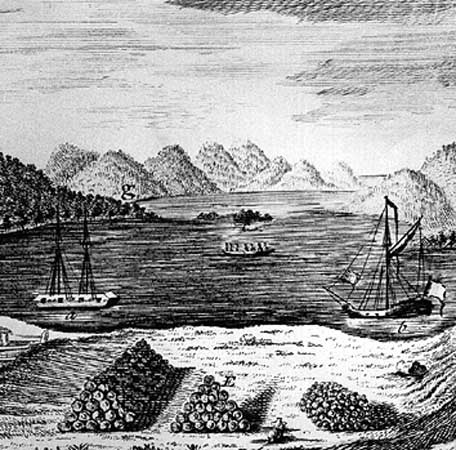 The European war between France and England in the mid-18th century had its counterpart in North America (the French and Indian War). The French, established along the St. Lawrence River and in Quebec, made a number of forays into northern and central New York. The strong Iroquois Confederacy aligned itself with the English in New York and New England because of aid given earlier by the French to rival tribes. This warfare discouraged settlement beyond Albany. The military situation was brought to a conclusion in 1763 by the Treaty of Paris (Paris, Treaty of), which confirmed English dominance of the New York region. A gradual but steady movement of settlers from New England was the beginning of New York's population explosion. The New Englanders moved across the borders of Connecticut and Massachusetts, some remaining on the east bank of the Hudson and others passing through Albany to the interior.
The European war between France and England in the mid-18th century had its counterpart in North America (the French and Indian War). The French, established along the St. Lawrence River and in Quebec, made a number of forays into northern and central New York. The strong Iroquois Confederacy aligned itself with the English in New York and New England because of aid given earlier by the French to rival tribes. This warfare discouraged settlement beyond Albany. The military situation was brought to a conclusion in 1763 by the Treaty of Paris (Paris, Treaty of), which confirmed English dominance of the New York region. A gradual but steady movement of settlers from New England was the beginning of New York's population explosion. The New Englanders moved across the borders of Connecticut and Massachusetts, some remaining on the east bank of the Hudson and others passing through Albany to the interior.In 1698 the colony's population was about 18,000, two-thirds of it concentrated in and around New York City. By the eve of the American Revolution, it had grown to 163,000, with the concentration nearly exactly reversed, but New York still ranked only seventh among the American colonies. Dutch culture remained strong in New York City and in Albany, while most of the settlements in the interior had a flavour and dialect of the New England Yankee; there were also several German communities. This emerging pattern of cultural heterogeneity was reported in 1782 by the French writer Michel-Guillaume-Saint-Jean de Crèvecoeur (Crèvecoeur, Michel-Guillaume-Saint-Jean de) (known in America as J. Hector St. John). He described the practices of the farmers along the lower Hudson valley and analyzed the forces creating the “American character.” He asked,
What then is the American, this new man?…He is an American, who, leaving behind him all his ancient prejudices and manners, receives new ones from the new mode of life he has embraced.…Here individuals of all nations are melted into a new race of men.… Americans are the western pilgrims.
This cultural diversity would continue to have a considerable influence on the politics of the state, as would the waves of immigration from Europe that followed the war and continued well into the 20th century.
Revolution, statehood, and growth
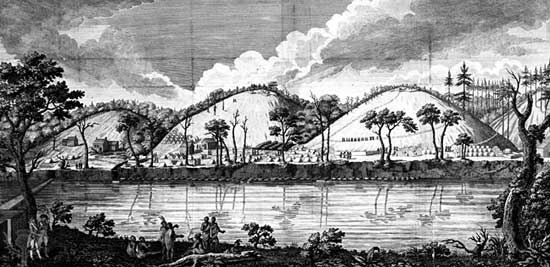 New York contains many of the battlegrounds of the American Revolution. The war in New York took on many of the characteristics of a civil war, since the area probably had a higher proportion of residents who were loyal to the crown than did any other colony.
New York contains many of the battlegrounds of the American Revolution. The war in New York took on many of the characteristics of a civil war, since the area probably had a higher proportion of residents who were loyal to the crown than did any other colony.Following the war a part of New York's leadership aligned itself with leaders from other colonies to urge establishment of a strong central government for the new country rather than the loose confederation that was then in power. New York delegates to the Constitutional Convention (1787), especially Alexander Hamilton (Hamilton, Alexander), played a notable role in the drafting of the Constitution (Constitution of the United States of America), but the politics of ratification within the state legislature were intense and bitter. New York became one of the last states—the 11th—to ratify the U.S. Constitution (Constitution of the United States of America). The first state capital was Kingston (1777); in 1797 the capital was moved to Albany.
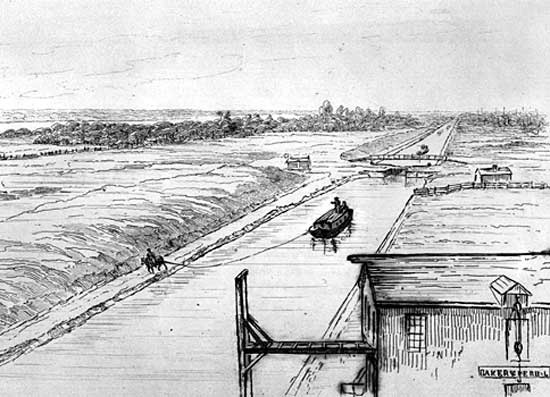 The American Revolution and the War of 1812 (1812, War of) temporarily interrupted New York's expansion to the west, but thereafter the movement began in earnest. Turnpikes spread westward from Albany and from other locations up and down the Hudson River, and settlers moved across the state. The opening of the Erie Canal in 1825 confirmed New York's position as the gateway to the lands being settled west of the Appalachians, and the cities on its route, including Rochester, Buffalo, Syracuse, and Utica, grew dramatically in the years following the opening of the canal. The railroads followed in quick order and tended to follow the pattern of trade that had been established earlier by the turnpikes and the canal.
The American Revolution and the War of 1812 (1812, War of) temporarily interrupted New York's expansion to the west, but thereafter the movement began in earnest. Turnpikes spread westward from Albany and from other locations up and down the Hudson River, and settlers moved across the state. The opening of the Erie Canal in 1825 confirmed New York's position as the gateway to the lands being settled west of the Appalachians, and the cities on its route, including Rochester, Buffalo, Syracuse, and Utica, grew dramatically in the years following the opening of the canal. The railroads followed in quick order and tended to follow the pattern of trade that had been established earlier by the turnpikes and the canal.According to the census of 1800, New York state had the third largest population in the Union, trailing Virginia and Pennsylvania; 10 years later it had surpassed all other states. Its leadership was not only in population, size, and growth but also in the areas of manufacturing, trade, and transportation—and in the increasing heterogeneity of its population. This fact was reported by French political scientist Alexis de Tocqueville (Tocqueville, Alexis de) while he was traveling through New York in the 1830s. He noted,
American society is composed of a thousand different elements recently assembled. The men who live under its laws are still English, French, German and Dutch. They have neither religion, morals, nor ideas in common; up to the present one cannot say that there is an American character, at least unless it is the very fact of not having any. There is no common memory, no national attachments here. What then can be the only bond that unites the different parts of this huge body? Interest.
Growth and change also were reflected in the political and governmental history of the state. The original state constitution restricted suffrage to property holders and established a governing system that was dominated by large property holders and leading commercial interests. The change in population composition, as well as shifting political attitudes in the country, soon caused New York to move in a more democratic direction. During the 1830s a vigorous campaign was launched against the system of landownership in the Hudson valley, with renters eventually being given the opportunity to own the land they tilled. The constitutional convention of 1846 confirmed these democratic moves by expanding suffrage among males and restricting the power of both legislature and governor.
New York became a centre of the woman suffrage movement during that period. A landmark convention on women's rights took place in Seneca Falls (Seneca Falls Convention) in 1848; subsequent conventions were held in Rochester later that year and in Syracuse in 1852. At the 1894 state constitutional convention, woman suffrage activists presented 600,000 signatures petitioning for the right to vote, though the effort failed. Women were not granted the vote in New York until 1917.
Emergence of political divisions
New York continued to grow in virtually every dimension, but its political development became centred on the increasing chasm of interest and affection between New York City and upstate New York. The issue of home rule—the demand of the city for total powers of self-government—remained central to the conflict.
During the 1780s an organization, eventually known as Tammany Hall, was formed in New York City to combat attempts by propertied Revolutionary leaders to limit the franchise. By the mid-19th century, Irish politicians had come to dominate the Tammany organization and the office of mayor. This trend culminated in the control of the Democratic Party machine after 1868 by “Boss” William Magear Tweed (Tweed, William Magear), under whose leadership the name Tammany became an international byword for municipal corruption. The existence of such a situation in predominantly Democratic New York City fueled antagonism between the city and Republican-dominated upstate New York.
Much of Tammany Hall's power was based on its social services to the waves of immigrants who had inundated New York City until changes in immigration laws slowed the tide during the 1920s. When the state and federal governments began to take over such services as social security, worker's compensation, unemployment, welfare, and health benefits, notably during the Great Depression of the 1930s, Tammany's hold began slowly to erode.
Strengthening and rebuilding
Between World War II and 1980, New York's social and educational services increased dramatically, while its industrial base eroded. This created a difficult financial situation for both the state and New York City, with the latter barely avoiding bankruptcy in 1975. In the last two decades of the 20th century, however, a succession of governors and legislative leaders were able to gradually reduce taxes and broaden the state's economic base. Led by financial services in New York City, centred on Wall Street, and by high technology in such upstate cities as Corning and Rochester, New York entered the 21st century in a position of economic strength and optimism. However, in 2001 the September 11 (September 11 attacks) terrorist attacks on New York City's World Trade Center crippled the economies of both the city and the state for a time. New York state responded by supporting the city's rebuilding efforts.
Additional Reading
Many aspects of the state are still usefully addressed in Writers' Program, New York, New York: A Guide to the Empire State (1940, reprinted 1972). Peter Eisenstadt and Laura-Eve Moss (eds.), The Encyclopedia of New York State (2005), is a thorough general reference to the state's geography, culture, and history. Physical features are described in John H. Thompson (ed.), Geography of New York State (1966, reprinted 1977); and are represented graphically in both DeLorme Mapping Company, New York State Atlas & Gazetteer, 7th ed. (2003); and New York Department of Transportation, New York State Atlas, 4th ed. (1998).Historical works include Milton Klein (ed.), The Empire State: A History of New York (2005); Michael Kammen, Colonial New York: A History (1975, reissued 1996); David Maldwyn Ellis, New York: State & City (1979); David M. Ellis, James A. Frost, and William B. Fink, New York: The Empire State, 5th ed. (1980); and Bruce Bliven, Jr., New York: A Bicentennial History (1981). Current research is reported in New York History (quarterly).
- Soga
- Soga Chokuan
- Soga Emishi
- Soga Iruka
- Ciano, Galeazzo, conte di Cortellazzo
- Ciaran of Clonmacnoise, Saint
- Ciardi, John
- Cibao Valley
- Cibber, Caius Gabriel
- Cibber, Colley
- Cibber, Theophilus
- Ciboney
- ciborium
- cicada
- cicada-killer wasp
- cicatrization
- cicely
- Cicely Tyson
- Cicero
- Cicero, Marcus Tullius
- Ciceronian period
- cichlid
- cicim
- ciconiiform
- cider